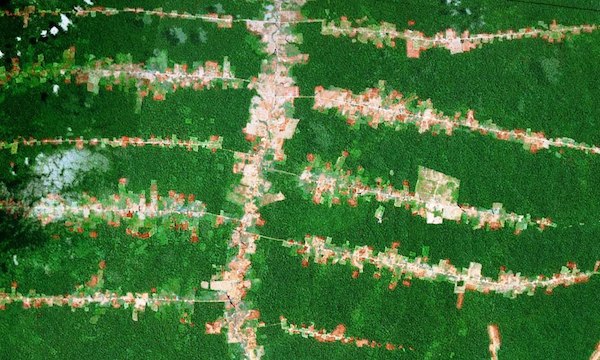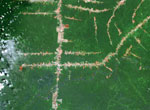Map shows where roads should be built, where they should not, and where human and environmental needs conflict
Roads make it possible to bring goods to market, to get to the office, to log a forest, to hunt its wildlife. Without roads, human society as we know it could not exist. However, to build roads, trees must be cleared and swamps drained, shrinking valuable wildlife habitat and fragmenting populations in the process. A new study, published today in Nature, unveils an innovative map that defines which areas of the world would best be used to build roads – and which should be left alone.
Scientists estimate more than 25 million kilometers of new roads will be built worldwide by 2050, representing a 60 percent increase over 2010 numbers. Many of these are slated for environmentally valuable places with high numbers of unique species and pristine forest, such as the Amazon Basin.

An Asian tapir (Tapirus indicus) killed on a highway in Peninsular Malaysia. Courtesy of WWF-Malaysia/Lau Ching Fong.
In addition to the direct environmental damage exacted to build a road, its very existence often leads to more degradation. According to the Alliance of Leading Environmental Researchers and Thinkers (ALERT), 95 percent of deforestation occurs within 5.5 kilometers (3.4 miles) of a road in the Amazon.
“Roads often open a Pandora’s Box of environmental problems,” said Professor William Laurance of James Cook University in Australia, a biologist and conservationist who studies the impacts of road expansion. “But we also need roads for our societies and economies, so the challenge is to decide where to put new roads – and where to avoid them.”
And that is exactly what Laurance and his colleagues set out to do in their new study. They created, in effect, a “global roadmap” for road creation that balances human development with environmental protection.
 A logging road slices through a rainforest in Sabah, Malaysian Borneo Photo by Rhett A. Butler. |
For nearly two years, the team worked to develop the map based on two components: the first illustrates the natural values of the world’s ecosystems, and the second identifies which areas where human communities would be most benefited by roads. To do this, they integrated a plethora of different datasets on regional factors such as biodiversity, ecosystem services, and number of endangered species present.
They also looked for the presence of small farms and areas that had already been converted for agricultural purposes.
“We focused on agriculture because global food demand is expected to double by mid-century, and new or improved roads are vital for farmers,” said Dr. Nathan Mueller from Harvard University. “With better roads, farmers can have improved access to fertilizers, information, and markets for their crops—the whole economic equation changes, which can make farming more efficient and profitable.”
Their result? A map that covers the entire 13.3 billion-hectare surface of the earth. They color-coded it, with green tones indicative of regions where conservation should have priority, and red tones where the benefits of road development would outweigh its risks.
“It was a challenge, but we think we’ve identified the most environmentally vital real estate on the planet,” said coauthor Andrew Balmford of the University of Cambridge, UK.

In this map, green-toned areas are priorities for conservation where roads should be avoided if possible, and red-toned areas are priorities for agriculture. Dark-toned areas are “conflict zones”—where environmental and agricultural priorities are likely to clash (light-colored areas are lower priorities for both environment and farming). Magnified images are shown for South America and Sub-Saharan Africa. Image from W. F. Laurance et al., 2014. Click to enlarge.
The team found many areas where agriculture and livelihoods could be improved significantly with the addition of roads, while exacting a relatively small toll on the environment.
“The good news is that there are still expanses of the world where agriculture can be greatly improved without large environmental costs,” said Dr Gopalasamy Reuben Clements from James Cook University.
However, the authors stress that in many other areas of the world, such as along the Amazon Basin, Southeast Asia, Madagascar, and high-latitude boreal forests, road-building would have huge environmental impacts.
The map also identifies conflict areas, where population growth will likely displace valuable natural habitat as agricultural expansion heats up to meet the needs of local communities. The most significant are found in Sub-Saharan Africa, parts of Central and South America, and a large portion of the Asia-Pacific region.
“We’re facing a lot of tough decisions,” said Irene Burgues Arrea of the Conservation Strategy Fund in Costa Rica. “For instance, there are huge conflict areas in sub-Saharan Africa, because it has vital wildlife habitats but a very rapidly growing human population that will need more food and more roads.”
Laurance and his colleagues hope their map will be used by governments and international funding agencies to help improve the ways in which roads are planned – and where they’re built.
“So much road expansion today is unplanned or chaotic, and we direly need a more proactive approach,” Laurance said. “It’s vital because we’re facing the most explosive era of road expansion in human history.”

Deforestation associated with forest roads in Roraima in the southern Brazilian Amazon. Image from Google Earth.
Citations:
- Laurance, W.F., Clements, G.R., Sloan, S., O’Connell, C.S., Mueller, N.D., Goosem, M., Venter, O., Edwards, D.P., Phalan, B., Balmford, A., Van Der Ree, R., and Burgues Arrea, I. (2014) A global strategy for road building. Nature, http://dx.doi:10.1038/nature13717
Related articles
The Gran Canal: will Nicaragua’s big bet create prosperity or environmental ruin?

(08/27/2014) A hundred years ago, the Panama Canal reshaped global geography. Now a new project, spearheaded by a media-shy Chinese millionaire, wants to build a 278-kilometer canal through Nicaragua. While the government argues the mega-project will change the country’s dire economic outlook overnight, critics contend it will cause undue environmental damage, upend numerous communities, and do little to help local people.
A paradise being lost: Peru’s most important forests felled for timber, crops, roads, mining

(08/12/2014) In 1988, when British environmentalist Norman Myers first described the concept of a “biodiversity hotspot,” he could have been painting a picture of the highly threatened Peruvian Andes mountain range. Today, the Andes are an immediate and looming portent of the fate of the Peruvian Amazon rainforest.
95% of Amazon deforestation happens near roads or major rivers
(08/05/2014) 94.9 percent of deforestation in the Brazilian Amazon occurs on land less than 5 kilometers from a road or navigable river, finds a new study published in the journal Biological Conservation.
Roads through the rainforest: an overview of South America’s ‘arc of deforestation’

(07/21/2014) When a new road centipedes its way across a landscape, the best of intentions may be laid with the pavement. But roads, by their very nature, are indiscriminate pathways, granting access for travel and trade along with deforestation and other forms of environmental degradation. And as the impacts of roads on forest ecosystems become clear, governments and planning agencies reach a moral crossroads.
30% of Borneo’s rainforests destroyed since 1973

(07/16/2014) More than 30 percent of Borneo’s rainforests have been destroyed over the past forty years due to fires, industrial logging, and the spread of plantations, finds a new study that provides the most comprehensive analysis of the island’s forest cover to date. The research, published in the open-access journal PLOS ONE, shows that just over a quarter of Borneo’s lowland forests remain intact.
Regional court kills controversial Serengeti Highway

(06/23/2014) The Serengeti ecosystem got a major reprieve last week when the East African Court of Justice (EACJ) ruled against a hugely-controversial plan to build a paved road through Tanzania’s Serengeti National Park. The court dubbed the proposed road ‘unlawful’ due to expected environmental impacts.
Feather forensics: scientist uses genes to track macaws, aid bird conservation

(06/17/2014) When a massive road project connected the ports of Brazil to the shipping docks of Peru in 2011, conservationists predicted widespread impacts on wildlife. Roads are a well-documented source of habitat fragmentation, interfering with access to available habitat for many terrestrial and tree-dwelling species. However, it wasn’t clear whether or not birds are able to fly over these barriers.
Oil company breaks agreement, builds big roads in Yasuni rainforest

(06/05/2014) When the Ecuadorian government approved permits for an oil company to drill deep in Yasuni National Park, it was on the condition that the company undertake a roadless design with helicopters doing most of the leg-work. However, a new report based on high-resolution satellite imagery has uncovered that the company, Petroamazonas, has flouted the agreement’s conditions, building a massive access road.
Scientists discover ‘shark’ in Sumatran forest

(05/28/2014) In early April, Indonesian scientists discovered an endangered freshwater fish in the Harapan rainforest of Jambi. The species had never before been observed in the region, and is declining elsewhere throughout its range.
Scientists urge ban on roads in intact wilderness areas

(03/21/2014) A group of prominent scientists chose to mark the second International Day of Forests by urging the world to support an initiative that aims keep wild areas free of roads. Roadfree, an initiative led by Member of the European Parliament Kriton Arsenis, has been growing in prominence over the past year, gaining supporters ranging from indigenous rights leaders to deep ecologists. Now the Alliance of Leading Environmental Researchers and Thinkers (ALERT) has thrown its weight behind the concept.
Proposed rail and road projects could devastate Nepal’s tigers and rhinos

(02/06/2014) Chitwan National Park is a conservation success story. Since its establishment in 1973 the park’s populations of both Bengal tigers (Panthera tigris tigris) and one-horned rhinos (Rhinoceros unicornis) have quintupled, a success achieved during a time when both species have been under siege globally by poachers. A UNESCO World Heritage site, the park is also a vital economic resource for locals: last year the park admitted over 150,000 tourists who brought in nearly $2 million in entry fees alone. But all this is imperiled by government plans for a new railway that would cut the park in half and a slew of new roads, according to a group of international conservationists known as the Alliance of Leading Environmental Researchers and Thinkers (ALERT).
Next big idea in forest conservation? Global road map to mitigate damage from roads

(01/17/2014) In the world of conservation, Dr. William Laurance is a household name. He has worked in tropical systems, worldwide, for over 25 years, publishing over 300 articles, five books and receiving numerous awards and honors for his work as a researcher, science communicator, and conservation practitioner, including one of Australia’s highest scientific honors, the Australian Laureate Award.
High-living frogs hurt by remote oil roads in the Amazon

(01/14/2014) Often touted as low-impact, remote oil roads in the Amazon are, in fact, having a large impact on frogs living in flowers in the upper canopy, according to a new paper published in PLOS ONE. In Ecuador’s Yasuni National Park, massive bromeliads grow on tall tropical trees high in the canopy and may contain up to four liters of standing water. Lounging inside this micro-pools, researchers find a wide diversity of life, including various species of frogs. However, despite these frogs living as high as 50 meters above the forest floor, a new study finds that proximity to oil roads actually decreases the populations of high-living frogs.














